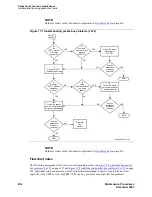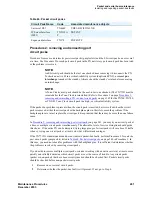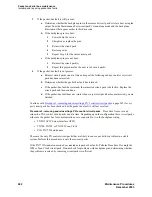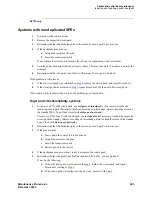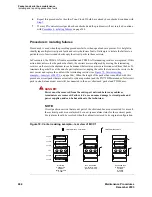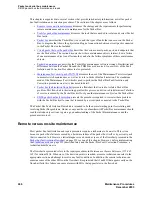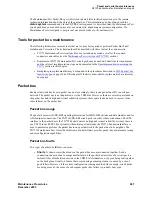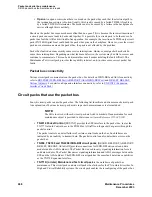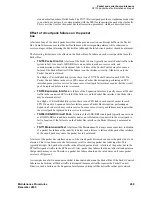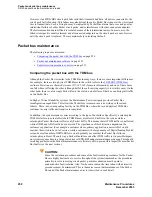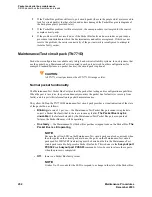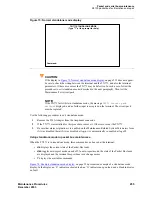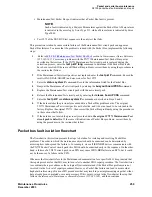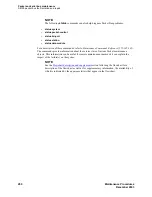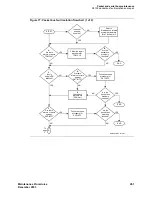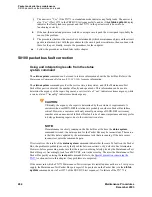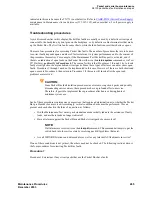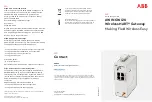
Packet and serial bus maintenance
S8100 packet bus fault isolation and repair
250
Maintenance Procedures
December 2003
However, if an ISDN-BRI circuit pack fails such that it transmits bad data, all devices connected to the
circuit pack fail to function. This failure may also disrupt the entire Packet Bus whenever the circuit pack
tries to transmit data. Such a disruption may be indicated by Packet Bus alarms that occur and go away,
intermittent failures of other Packet circuit packs, and/or interference with other connected endpoints.
The failures mentioned are difficult to isolate because of their intermittent nature. In most cases, the
failed circuit pack is usually alarmed, and all connected endpoints on the circuit pack are out of service
until the circuit pack is replaced. These symptoms help in isolating the fault.
Packet bus maintenance
The following topics are discussed:
•
Comparing the packet bus with the TDM bus
•
Packet bus maintenance software
•
Fault correction procedure overview
Comparing the packet bus with the TDM bus
Although the Packet Bus is similar to the TDM Bus in many ways, there are some important differences.
For example, there are two physical TDM Buses in the switch (refer to the
section in Maintenance Alarms Reference (555-245-102) for more information), and one of these buses
can fail without affecting the other (although half of the call-carrying capacity is lost in this case). On the
other hand, there is only a single Packet Bus in the switch, and a failure of that bus can disrupt all traffic
on the Packet Bus.
In High or Critical Reliability systems, the Maintenance/Test circuit pack provides Packet Bus
reconfiguration capabilities. This allows the Packet Bus to remain in service with up to three lead
failures. There is no corresponding facility on the TDM Bus, where the second physical TDM Bus
continues to carry traffic until repairs are completed.
In addition, the system response varies according to the type of bus failure. Specifically, a catastrophic
TDM Bus failure (one that affects both TDM Buses) disables ALL traffic in the system, while a
catastrophic Packet Bus failure affects only Packet traffic. This means that all TDM traffic is unaffected,
while all BRI and ASAI traffic does not work. The significance of this distinction depends on the
customer’s application. (For example, a customer whose primary application requires ASAI would
consider the switch to be out of service, while a customer with a large number of Digital/Analog/Hybrid
sets and a small number of ISDN-BRI sets would probably not consider the Packet Bus failure a
catastrophic problem.) The only way a Packet Bus failure can affect TDM traffic is via possible impact
on system response time in a large switch due to ISDN-BRI endpoint maintenance running. This should
rarely happen because the Packet Bus maintenance software is able to prevent this impact for most Packet
Bus faults (see the next section).
CAUTION:
Since the correction procedures and some of the fault isolation procedures for the Packet
Bus are highly destructive to service throughout the system (inasmuch as the procedures
primarily involve removing circuit packs), particular attention must be paid to
nondestructive fault isolation. Also, for the same reason, the time taken with destructive
procedures must be minimized. This is the major reason that maintenance of the Packet
Bus and of the Packet maintenance objects is described in such detail.
Summary of Contents for CMC1
Page 1: ...Maintenance Procedures 555 245 103 Issue 1 1 December 2003 ...
Page 14: ...Contents 14 Maintenance Procedures December 2003 ...
Page 416: ...Additional maintenance procedures IP Telephones 416 Maintenance Procedures December 2003 ...
Page 426: ...Index X 426 Maintenance Procedures December 2003 ...

